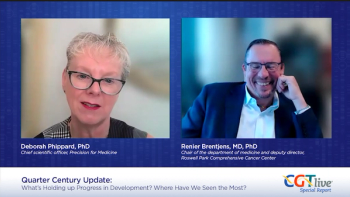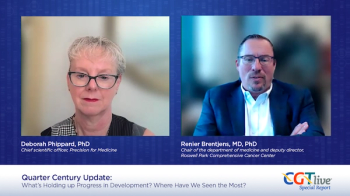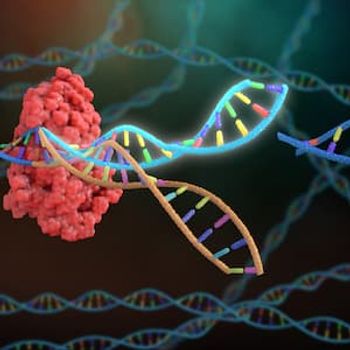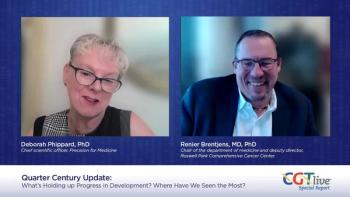
Kedar Kirtane, MD, on CAR T-Cell Agent A2B530 and Its Unique Approach to Solid Tumors
The assistant member in the Department of Head and Neck-Endocrine Oncology at Moffitt Cancer Center spoke about A2B530's mechanism of action and how it could represent a leap forward in the application of CAR T-cell agents for patients with solid tumors.
There have been many challenges in the attempt to replicate the successes of chimeric antigen receptor (CAR) T-cell therapies for patients with solid tumors. Now, though, another attempt is being undertaken with a novel CAR T-cell agent, A2B530, which is set to be assessed in the upcoming phase 1/2 EVEREST-1 trial (NCT05736731).1
Kedar Kirtane, MD, the physician director for engagement of special populations for clinical trials and an assistant member in the Department of Head and Neck-Endocrine Oncology at Moffitt Cancer Center in Tampa, Florida, said in an interview with CGTLive™'s sister publication, OncLive®, that those with solid tumors could see real benefit from this type of of cell therapy. “Cell therapies are the future of immunotherapies for metastatic cancers and I hope that we can come to a point where we can start curing a lot of these patients, rather than just controlling their disease for a temporary amount of time," he said.
EVEREST-1 will enroll approximately 160 adult patients with recurrent unresectable, locally advanced, or metastatic solid tumors that express carcinoembryonic antigen and do not express HLA-A*02. Tumor types that will make up the trial include pancreatic, colorectal, and non–small cell lung cancer.1 Eligibility criteria include a life expectancy of at least 3 months, an Eastern Cooperative Oncology Group (ECOG) performance status of 1 or less, previous therapy for solid tumor, and adequate organ function. On the other hand, those who have undergone prior allogeneic stem cell or solid organ transplant, cancer therapy within 3 weeks or 3 half-lives of A2B530 infusion, or radiotherapy within 28 days of A2B530 infusion will not be included.
The coprimary end points of the phase 1 portion of the study are the rate of adverse events and dose-limiting toxicities. This stage of the study will also seek to determine the recommended dose for phase 2, in which the primary end point will be the overall response rate. The secondary end points include the persistence of A2B530 and cytokine analysis.
An additional criterion for eligibility for the EVEREST-1 trial, is that patients must first be appropriately enrolled in the prescreening BASECAMP-1 study (NCT04981119). BASECAMP-1 is a noninterventional, observational study that is designed to compile information with next-generation sequencing about how the loss of HLA heterozygosity in a solid tumor might occur. Those enrolled will undergo apheresis and have T cells stored for future use to produce A2B530 to be used as part of EVEREST-1 treatment.2 There is no time requirement between the studies, allowing patients to go directly from BASECAMP-1 to EVEREST-1 based on their own disease course.1
In this conversation, Kirtane discussed the unique mechanism of action of A2B530 and how the agent could represent a huge leap forward in the application of CAR T-cell agents for patients with solid tumors if the EVEREST-1 study proves positive.
OncLive: What are some of the unmet needs for patients with solid tumors that led to the initiation of the EVEREST-1 trial?
Kedar Kirtane, MD: We have set such a low bar for success in metastatic solid tumor cancers, that we are willing to accept minimal increases defined by a few extra months of survival for these patients. We need to have a therapy that can really extend life much longer than that, and [aim to] replicate what's happened in hematology with CAR T-cell therapies [where] people can have disease all over their body and many of those patients end up being cured.
Obviously, these are fundamentally different cancer types, and within solid tumor cancers there's a variety of different malignancies, but the goal is to try to help cure many of these patients long-term rather than just providing an extra couple months of survival.
I take care of head and neck cancer patients and my patients who have recurrent or metastatic disease have really 1 therapy they can receive, which works approximately 15% to 20% of the time. So, 80% of the time, I'm going into a clinic room discussing a scan and I have to say that that cancer has progressed on that scan. There's a lot of room for improvement for many of these types of cancers.
What makes the trial design of EVEREST-1 different from other trials?
It's a unique design for a cell therapy trial. There's a master screening protocol called BASECAMP-1, where we are [enrolling] patients who have a very high risk for recurrence of their disease, whether that's colorectal, pancreatic, or lung cancer, and prescreening them for a particular blood test [result] that helps us determine eligibility for our subsequent therapeutic trial, EVEREST-1.
What is unique about this clinical trial and this cell therapy product is that it has created a unique mechanism that can distinguish tumor from normal cells. A part of that is dependent on figuring out whether a patient has that particular blood test [finding] that's relevant for EVEREST-1, and also sequencing their tumor. We're getting a lot of the prescreening out of the way, figuring out who could potentially benefit from the therapy very early on. The nice thing is that it takes advantage of a common finding in cancer, loss of heterozygosity and this is an abnormal finding for about 20% of patients with solid tumor cancers. This unique mutation allows the cell therapy product to differentiate normal from abnormal tissue.
What differentiates AB5230 from other CAR T-cell therapies?
[A2B530 uses] a novel Tmod platform that leverages the loss of genes in tumors to protect normal cells and kill tumor [cells]. Basically, this CAR T has an activator and a blocker and the activator binds antigens that are uniquely expressed on tumor and the blocker binds antigens only expressed on normal cells. Basically, if one of these Tmod T cells encounters a normal cell, the blocker will block and the activator won't activate, but if it encounters a cancer cell the blocker won't be engaged, and the activator can destroy that tumor cell. It surveys both normal and abnormal cells and it can differentiate between the 2, which is the unique characteristic that will hopefully improve the safety and efficacy of this cell therapy.
How does EVEREST-1 have the potential to shift the treatment landscape for patients with solid tumors?
This [trial] is really aiming for the stars because this has the potential to not only move the needle but significantly change the paradigm through which we treat many of these patients. As I mentioned, 15% to 20% is not a good response rate, and we've accepted that as our standard for many of our solid tumor cancer patients. If this works, it has the potential to drive a completely new paradigm and a new pillar for cancer treatments.
Most of the existing [agents] have difficulty differentiating between normal cells and tumor cells. [Although] you can have targeted therapies for tumors, it also ends up damaging normal cells, which would limit the safety and efficacy of these solid tumor cancer therapies.
Are there any safety concerns with A2B530 that investigators will pay particular attention to in this trial?
The big safety concern is to ensure that that blocker really blocks because that's the [agent’s] unique way to differentiate between normal and abnormal tissue. We have to make sure that when the patients are treated on this trial, they are not experiencing major [adverse] effects. With any clinical trial, we need to make sure that it's safe and that's one of the primary end points of the trial; once it's established that it's safe then we need to make sure that it's effective for patients.
What does the future hold for this research?
This trial is focused on 1 HLA type and my hope is that if this is proven to be safe and effective, then we can expand those HLA targets long-term so that they include a very diverse population of patients because we don't want this to be only allowed for a certain patient population. Hopefully, once we have proof of concept, we can start expanding targets and expanding these HLA types as well.
REFERENCES
1. A study to evaluate the safety and efficacy of A2B530, a logic-gated CAR T, in subjects with solid tumors that express CEA and have lost HLA-A*02 expression (EVEREST-1). ClinicalTrials.gov. Updated February 21, 2023. Accessed April 10, 2023. https://www.clinicaltrials.gov/ct2/show/NCT05736731
2. Solid tumor analysis for HLA loss of heterozygosity (LOH) and apheresis for CAR T- cell manufacturing (BASECAMP-1). ClinicalTrials.gov. Updated March 22, 2023. Accessed April 4, 2023. https://clinicaltrials.gov/ct2/show/NCT04981119
Newsletter
Stay at the forefront of cutting-edge science with CGT—your direct line to expert insights, breakthrough data, and real-time coverage of the latest advancements in cell and gene therapy.











































